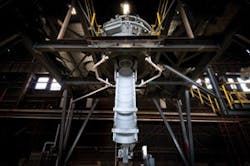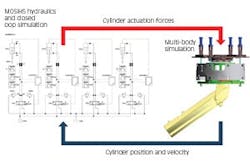Check Out Montague's Google+ profile.
Simulations used to be so simple. They might involve a huge amount of data, but it could be chewed on for awhile. Then researchers could draft a report a few days or weeks later and make recommended adjustments to optimize a process application. Well, events are moving a bit more quickly now.Simulations that long ago moved from static to dynamic are now so close to real time that they basically optimize processes on the fly. This can enable faster performance, but it also means coping with more complexity in much less time. In short, simulation is another job for data processing and software that can have big-time paybacks.
Optimizing Biofuels from Pulp
For instance, Chemrec's plants in Pitea and Domsjö, Sweden, recently implemented UniSim simulation software from Honeywell Process Solutions to simulate and optimize its process of turning waste from pulp and paper mills into biofuels.
Chemrec's process uses high-temperature, entrained-flow gasification of black liquor, which produces syngas—a gas mixture of mostly hydrogen and carbon monoxide that's the feedstock for several biofuels. Chemrec wanted to capitalize on its process and needed an in-house technology to help test and simulate its processes, so they could move beyond pilot-scale operation and engineer a full-scale plant.
This Essentials Guide from the editors of Control discusses how dynamic simulators can be used to both reduce risk and improve profitability throughout a plant's full lifecycle — from testing and troubleshooting of control logic, through experiential training of plant operators.
[javascriptSnippet]
Consequently, Chemrec selected UniSim Design software to design and simulate its process. UniSim helps evaluate alternative uses of syngas and trys out different process configurations and products. Chemrec can also use UniSim to simulate properties of concentrated electrolyte solutions, which are very important for pulp mill integration.
Figure 1: Woodings Industrial's burden distributor uses four hydraulic cylinders to precisely control its chute, which rotates though 360° and is lifted and lowered to precise endpoints to carefully add tons of iron ore and coke pellets to two blast furnaces in China for more efficient melting and production.
Photo courtesy of Bosch Rexroth
Modeling Moves
Even motion control in process applications is getting in on the simulation act. For example, Woodings Industrial Corp. in Mars, Pa., recently had just nine months to develop a new hydraulic circuit and distributor for two 4150 m3 iron blast furnaces in China to provide better burden distribution control, improve motion control and endpoint accuracy, and increase efficiency and production to up to 16 million metric tons of iron per year.
"The way iron pellets and coke are charged in layers inside a blast furnace really affects the melting process," says Al Colucci, Woodings' engineering vice president. "The layers are created by a hydraulic distributor, which rotates at 8 rpm, and then tilts a chute in the throat of the blast furnace to deposit iron ore and coke pellets in precise locations. Our challenge was to develop more accurate hydraulic distributor control and achieve unheard of control levels."
While most burden distributors use electromechanical gearing, it's hard to maintain and repair in the heat above the blast furnace. These high temperatures also require the hydraulic valves controlling the distributor's four hydraulic cylinders to be located away from it. This requires long hydraulic lines, which create spring-like expansion and contraction of the fluid in them, and makes motion control even harder. The cylinders are controlled by Bosch Rexroth's 4WRPEH directly operated, high-response, directional, proportional valves with electrical position feedback.
Woodings adds that its Chinese client wanted to limit chute movement at the endpoint to no more than 0.25 mm, which is one-tenth of a degree. Typical distributor endpoint accuracy is within inches, but the steelmaker was certain greater accuracy would make its furnaces more productive.
To verify the targeted accuracy and repeatability of its new hydraulic system, Woodings used Bosch Rexroth's Modular Simulation of Hydraulic System (MOSIHS) software and library of parameterized hydraulic devices. Sub-models of the hydraulics, mechanicals and controls also were coupled with each other and simulated together, which allowed designers to investigate dynamic behavior of the whole system. The distributor's hydraulic circuit and controls provided input data for the MOSIHS software, while CAD drawings of the distributor, chute and rotating distributor head were imported into a commercially available, multi-body simulation program coupled with MOSIHS (Figure 2).
Figure 2. A simulation model of Woodings Industrial's hydraulic distributor circuit shows how it uses Bosch Rexroth's Modular Simulation of Hydraulic System (MOSIHS) software to model cylinder actuation forces in a closed loop and improve chute position and velocity.
Graphic courtesy of Bosch Rexroth
Better Software Tools
Not surprisingly, one force enabling simulations to get closer to real time and be applied in new applications is improvements in software, especially for handling several applications.
For instance, AspenTech has launched the latest version of its aspenOne software, V8.3, to enable faster optimization of upstream, midstream and refining processes and improve plant safety. New capabilities of Aspen Hysys software include: Acid Gas Cleaning, which models gas sweetening units in one environment in Aspen Hysys, and Pressure Safety Valve Sizing, which lets users size pressure safety valves as part of the process design.
"We can now access the aspenOne and Hysys simulation environments in one click, and users are immediately informed about their target's present performance, what optimization opportunities exist and what changes are needed to get there," explains Vikas Dhole, engineering and product management VP at AspenTech. "We're also able to show economic analysis and the costs of opportunities and potential profits of making changes. We also have a web and mobile interface for aspenOne that combines model and plant data, and a new aspenOne Exchange that allows a community to share multiple solutions."








